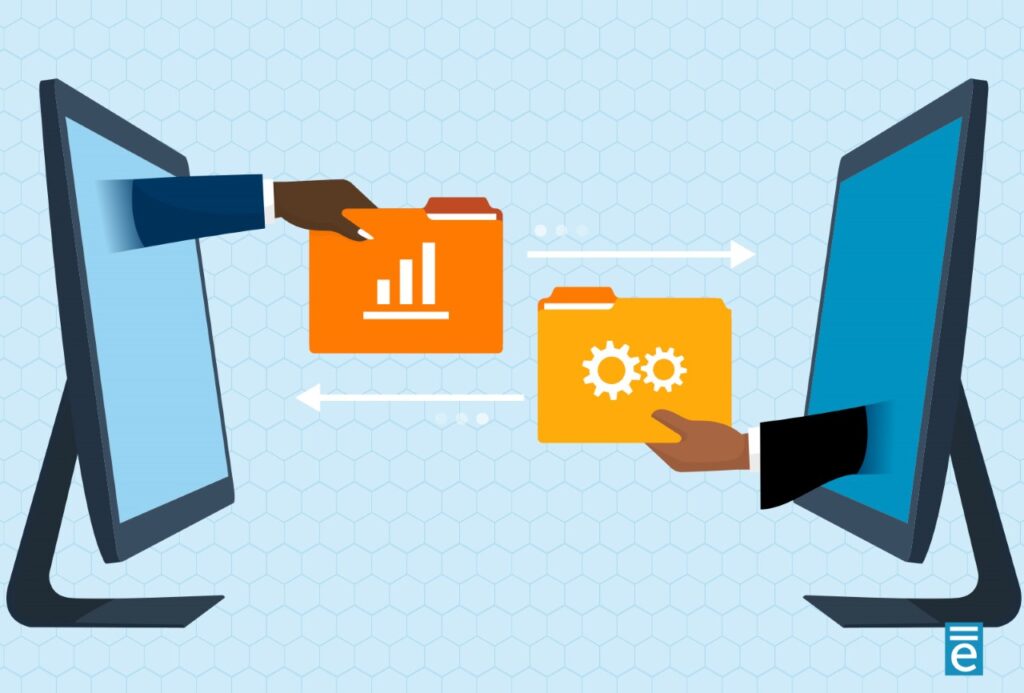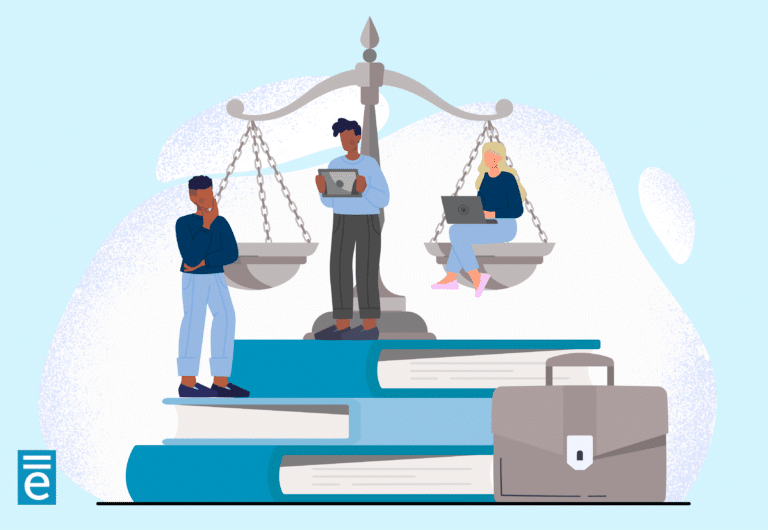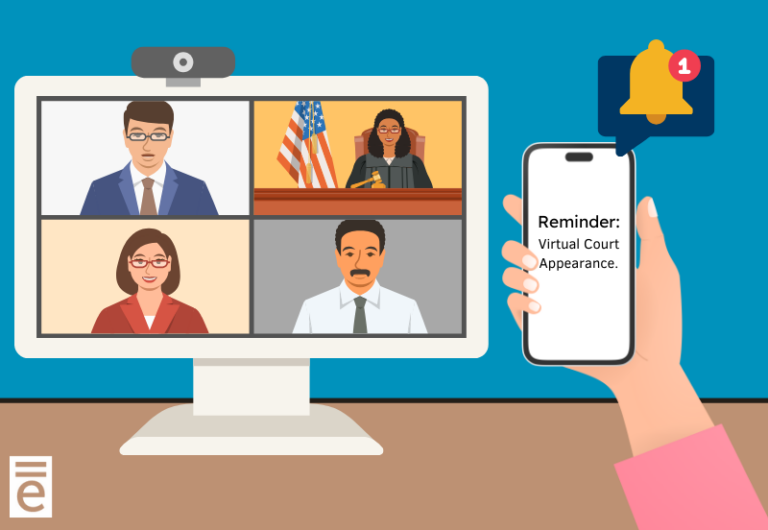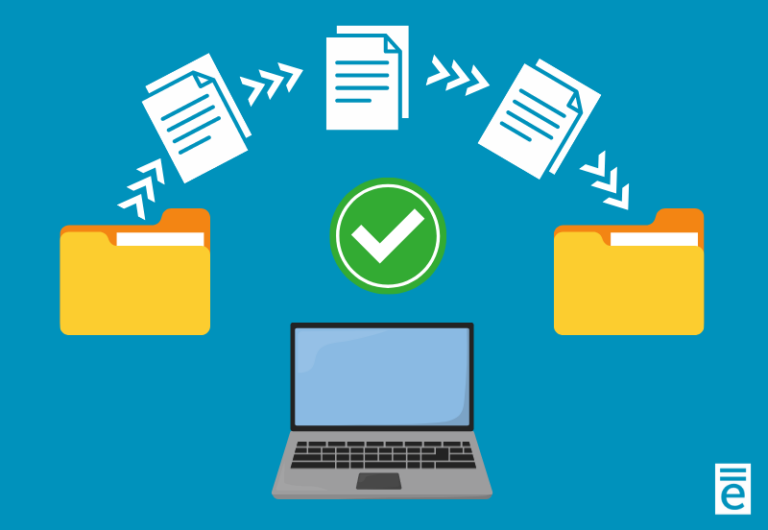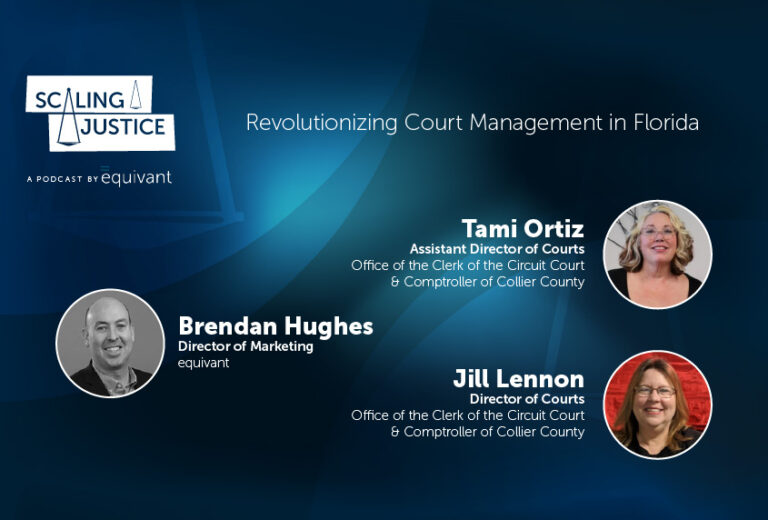Explore Data Exchange Benefits and Learn Simple Tips for Effective Sharing
Keeping communities safe and ensuring justice works efficiently relies on effective data-sharing processes. While this might sound intimidating (and slightly mundane), courts nationwide recognize the power of sharing and accessing data to make it easier to do their jobs and advance justice.
Join Patricia Jacoby, equivant Director of Development for Court products, and explore the benefits of data exchanges in non-IT terms. Get simple tips to get the most out of data sharing and learn why data exchange setup is easier than you think.
Watch now:
Related Links
Blog post: 3 Reasons Courts Should Get Excited About Data Sharing
3 Reasons Courts Should Get Excited About Data Sharing Transcript
Brendan Hughes: My name is Brendan Hughes, and this is the Three Reasons Courts Should Get Excited About Data Sharing. Hello and welcome. So I am the director of marketing at equivant, and I’m joined by the director of development, Patricia Jacoby. And she’ll get started and introduce herself in just a minute. But I wanted to set the stage for this webinar. So while often mentioning the word data can glaze over eyes and produce negative reactions, I actually think today’s topic is really interesting and timely in the court and justice space. And we start with somewhat of a bold statement there at the top of the screen. Data is key to the justice system, and accurate and accessible data effectively shared across all stakeholders is the key to keeping the community safe and justice working efficiently. And all the fancy technology and latest process, best practices, nothing can make a court or justice agency run well and justice served appropriately if data is bad or confusing or unavailable or delayed.
Now this seems like a very straightforward and simple concept. Good data makes everything work. We all know in the real world, having accurate, accessible, timely data for courts to function seems a little bit more like make-believe than reality. So as you guys probably know, there are many data challenges facing courts and justice agencies, especially when having to rely on data from a different source, a different agency or court, whether it’s in your district, county, or state or from even farther away. You guys know every court and justice agency has reporting requirements or laws to comply with, and those laws dictate how the data is presented and reported. But these are often different based on the jurisdiction. Plus, each court is very unique when everyone and everyone is collecting data of a similar nature. The code’s definitions and the way it’s collected can be slightly different or really, really, really different.
So then when you’re having to share that information or rely on that information from a different source, it can be really hard with these variations and differences, plus dated or ineffective processes and procedures for staff or dated or no technology support can really exacerbate these issues. So right now I am not making data sound exciting, am I? Fortunately, that’s why we’re here and Patricia’s here. This is something at equivant we’re passionate about, data sharing, data exchanges, improving efficiency through technology to make the work lives easier for court and justice staff and ultimately improving the way the whole system works. So Patricia is going to answer some questions that I am going to pose to her and she’ll speak on the data exchange basics and why you should be interested and excited about it. And all of this is from the perspective of a non-IT non-technical person.
In layman’s terms, we’re going to review why this is fun and exciting. So Patricia’s going to… the things that she’s going to touch on are great for anyone who’s addressing this for the first time, but it’s also perfect for people who are looking to evaluate, audit what the existing setup is or if you’re trying to improve on what you already have. And we’ll probably touch on a few advances in technology as well.
All right, so kind of set that all up a little negative at the first, but this is why we’re here to address it and why we think it’s so exciting. So just a quick overview. We’re going to introduce ourselves and equivant, then we’ll talk with Patricia and I’m going to prompt her with some questions in a Q&A format and then summarize this and take any questions that you might have. If you want to ask questions, please just use the chat function. I’ll keep an eye on it and if I see any questions, I’ll make sure that we address it. All right, and onto the next. So again, my name is Brendan Hughes. I’m director of marketing at equivant. Now one of my main goals is to bring awareness to our subject matter experts like Patricia and the innovative solutions they’ve developed over decades to help build more efficient, effective, and equitable justice agencies nationwide. But Patricia is definitely the star of the show and I’ve been talking way too much so far. So Patricia, why don’t you introduce yourself?
Patricia Jacoby: Yep. I’m Patricia Jacoby. I’m the director of development at equivant court products and I’ve actually been in software development for over 29 years, both in the private and government sectors. I started as an application developer, so I’ve done application development, I’ve done database administration, I’ve done quality assurance testing, I’ve done business analysis, project management, and customer care. But the only thing I haven’t done is sales, but I think it’s pretty safe to say that I’ve kind of seen every aspect of the software development cycle and have seen what does and does not work for successful software implementation and usage.
Brendan Hughes: Great. Great. We are definitely in good hands with Patricia here today. So just before I jump in, I wanted to provide a high-level overview of equivant so you know beyond just our personal qualifications, a little bit more about equivant and equivant has been developing and implementing innovative justice solutions for more than 30 years. And those solutions have always been focused on items like the topic of this webinar, things that we can do to make courts and justice agencies more efficient and effective. Our job is to make your jobs easier. And just for reference, I have a few numbers up here on the screen and I’m not going to spend much time on this because everyone’s here to listen to Patricia, but I do want to emphasize two things. One, our mission is to simplify justice for all. We build innovative solutions to simplify justice. Our passion and the reason we are in business is to make your work environments better and make your lives easier.
And second, the knowledge and expertise from our staff, you can see it on the screen there, is a differentiator in second to none, and you can see the longevity in the technology and in this industry. But more than that, many of our people come from courts and justice agencies. They’ve been in your shoes, they know the challenges and opportunities you face, and it’s really what helps us create solutions that really work for courts and justice agencies. All right, enough of all this preamble, let’s get to the exciting stuff. Patricia, why should anyone be excited about data sharing?
Patricia Jacoby: All right, so the main reason for data sharing, for getting excited about data sharing is that when it’s done correctly, it will dramatically increase efficiency and accuracy for agency or staff personnel. It just makes life easier. First of all, it reduces redundancy between law enforcement agencies and courts. Data is entered once at a relevant agency or at the court and then it is transported and imported into the other agency systems where it’s immediately available for use. Traditional time-consuming activities like data entry at each agency based on paper are eliminated. So it just makes things faster. It ensures consistency between agencies. One of the glorious aspects of the American judicial system is that every county and every court, every agency really has the autonomy to decide the daily processes and codes that best suit their needs and their daily work. The downside of this autonomy is that everybody does things a little bit differently.
Everybody uses different codes and there’s no consistency. So data sharing at its best forces this consistency among the agencies, increasing efficiency and accuracy. At its worst, it allows you to translate and map codes from one agency to another. Again, making things more efficient. Nobody has to manually enter or guess what a code would be at one agency versus another. And the third thing is that data sharing allows agencies to have all this data available to them to help them in making better informed decisions. If you know all the facts, you can make better decisions. So as an example, there’s currently an effort underway among some of our clients, some of our state clients, to centralize data sharing in terms of eWarrant creation.
So whereas previously creation of warrants and the checking of status of warrants was something that was paper-based and required a lot of manual efforts both at the courts and at law enforcement agencies, now with it being shared digitally at a single state system, will allow the warrants to be created uniformly quickly, digitally, and everyone can check them at will just by logging in and looking up a particular individual. This not only helps eliminate liability at the agency sites. For example, if somebody has a warrant out for their arrest because they have excessive unpaid traffic tickets and they decide that this is the day they will actually pay them, the beauty of data sharing is that as soon as those tickets are paid, the system updates everyone with the fact that this person’s tickets have been paid and the warrant is no longer active. Previously, you’d have to wait for that information to make its way to all the different agencies. And there was always a risk that this individual could still get arrested even though they’d already cleared those tickets. So those are really three good reasons to get excited about data sharing.
Brendan Hughes: Yeah, that’s great. And I’m sure many of us can think of numerous examples where bad data created a problem or many problems, and then looking back better data exchange or information could have avoided those problems. I think your eWarrants example is perfect on that, where with a synced integration of data, you can avoid some of those things that have probably happened to a lot of people in the past that cause problems both just slowing down efficiency and real issues for people. So I’m excited now with all the possibilities and how much better our work lives could be with the sharing data. But now that we’re all excited about this, what are the things that we need to know and be aware of before we get started?
Patricia Jacoby: Okay, so it’s important to approach data sharing with a plan upfront. And again, we seem to be stuck on threes here, but threes are good numbers. The first thing is you need to know who all will be involved in this data sharing, who are the entities, who are the law enforcement agencies? Who are the courts? The reason for needing to know this upfront is you’ll need the participation of each of these entities to agree on not only what data will be exchanged and in what format, but to ensure that consistency in codes will you be actually all standardizing your codes? Will you be mapping and translating your codes? So you need to know who you know need to know why you’re doing this. The second important thing to know is who owns the data? What is the system of record?
Usually it’s the court’s, but there are some circumstances where another agency’s data could actually trump the courts.
As an example, if you have a court case with a participant and the court has a phone number for that individual, but a law enforcement agency has a different phone number for that individual pertaining to a particular case in charge, the big question is whose phone number is the most current and the right one? So those things need to be addressed and you need to know ultimately who does own it? Who trumps who, whose data trumps whose?
The third thing is not only what data exactly will be transmitted between agencies, but is it unidirectional? Does it flow outward from the court? Is it bidirectional? Does it flow outward from the court, inward from the agencies? Is it as simple as data that needs to be used for a lookup? So it could be bidirectional… a unidirectional outward flowing piece of data, or is it as complex as an incoming piece of data that will initiate a case at the court, say from a prosecutor’s office or from a law enforcement agency? So you need to establish that sort of thing. So the who, who owns it, and the what, and the why. So those are really the big things you need to know.
Brendan Hughes: Yeah, those are great questions to be asked at the start and the pre-planning, I think about this for just about any technology solution or process that these are probably important questions to get answered at the outset before you begin planning. Who’s the owner of the data being a big one and what trumps who and what. So great ideas on what to be aware of before you even get started. So some of that is kind of process oriented, but let’s talk a little bit about technology now. And one of the things that we are addressing in this is how competent do you need to be? How tech-savvy do you have to be implement some of this data sharing stuff? And then every quarter jurisdiction has probably their own software case management solutions. And so how does maybe new technology or other technology tools and all that integrate and work together with this tech savviness?
Patricia Jacoby: Okay. So actually it’s really up to the courts or each agency exactly how tech-savvy you need to be or how tech-savvy you want to be. The first option is the low tech, non-tech savvy version of it where the third party vendors such as equivant would actually create all your interfaces for you. You do not need to understand technology beyond maybe your basic IT staff. If the interfaces are going to be hosted at your site, then your basic IT staff, those who handle your environment would need to be involved. Beyond that, we would need subject matter experts, those who understand the business, who understand the way the processes work at your particular establishment, but there’s no real need to be tech-savvy at all.
The second option, if your establishment is particularly tech-savvy, you may have developers on staff or you have a crack IT group and you want to write those interfaces yourself, we can assist you with that. We have tools that we have created that we actually use ourselves in writing our own interfaces. We have our own equivant IJIS Broker tool, for example, which is basically an interface development platform. It facilitates the steps for building it, and we essentially would train you how to use that tool. There are other tools out there on the market with other vendors as well, but those are kind of your two options. You can either let us do everything for you or you can do the writing of the interfaces yourself with help and guidance from us. In either case, we would need subject matter experts on your side who understand the way you do business, the way data flows through your establishment.
Brendan Hughes: Great. Yeah, and it sounds… What I like about your answer there is that most of the people that are probably interested in this topic are the subject matter experts and then the various degrees of support that they have or their own tech knowledge that there’s options for them. And I’m sure we know there’s large differences in the scale of courts and justice agencies and the resources they have. And so I think it’s a bit comforting to know that there’s options for no matter what size you are, but the key is going back to the items you mentioned before with the subject matter experts and having a plan and knowing where they want to get and what they want to accomplish. And then there there’s ways to get there. So good insights there. Just recap a little bit here. At the start, we said that data is the key to making justice work, but it’s hard, you just don’t automatically have good clean data.
The reporting requirements and laws vary by agency, jurisdiction and state, and each specific court or agency can be collecting report on similar data, but they have unique codes and definitions and all this makes it hard to share and access the data. And then on top of that, we know there aren’t many standards and depending on what your court or justice agency is doing, could have old technology or ineffective processes, makes everything seem frustrating and going back to that word hard. But Patricia came in and has saved the day.
She relieved all that negativity that I was spouting and brought excitement to this because there is some data exchanges, there’s ways that can solve these problems that are powerful. And Patricia outlined what you need to know to get started and what you need to do and decide before you even get started, the plan before the plan. Patricia just mentioned too about the IT tech savviness and how tech-savvy you have to be. And what’s nice is that you don’t have to be… or whatever tech savviness level you or just your court or justice agency is, there’s a solution for you. So Patricia, just as you outlined all these things, from your experience and background, what’s the biggest obstacle that you see people run into when they try to accomplish these data exchanges and making life easier on themselves? What do they run into the most that you see?
Patricia Jacoby: So the biggest obstacle really is people being afraid to be involved or actually not wanting to be involved. The subject matter experts are critical to this. So pretty much any interface has two end points, either it’s the court and a third party vendor or it’s the court and two third party vendors. And I’ve had it happen before where the courts or the agencies sort of said, “Okay, third party vendor one and third party vendor two, you two work this out amongst yourselves and create us an interface.” And that lack of involvement on the court side, I mean the two vendors can certainly, they’ll code away and they’ll create something, but it won’t be what the court or the agency was looking for. We don’t know the codes, we don’t know each individual court’s or agency’s business process because again, everybody’s is different. So the biggest obstacle really is lack of involvement on an agency or courts apart.I can’t encourage or strongly stress enough that the sooner you get involved upfront, the more smoothly this will work. A second obstacle would be to not having a plan for the user acceptance testing phase. How are you going to basically test this from your establishment’s business process aspect and decide, “Yes, this is working exactly how we expected it to”? The biggest obstacle we find there is nobody has that plan, again, that involvement upfront and the user acceptance testing phase turns into the, “Well, let’s try and figure out a plan,” and it tends to stretch out forever. So those would be the two biggest obstacles we’ve run into.
Brendan Hughes: Great. Yeah, that’s again, really good insight on especially the subject matter experts and what we’re trying to accomplish here is to make the data seem less intimidating, which it is based on a lot of the things you outlined. So this is really good and I appreciate that. Now, so one of the things that Patricia mentioned earlier was our… we have a great powerful data sharing and integration tool. So if you want to discover more, you can download our solution sheet about it. It’s called the IJIS Data Broker and Integrator. You can go to the URL or use the QR code. If you hadn’t noticed yet, but the presentation is available for download in the box below this screen. So if you want to click on that link, you can just download the presentation, you have all the slides, and then you can download this data broker and integrator.
So well, we’ve reached the end and I’m not seeing any questions right now I think. If you have any questions, you can put it in the chat, but I’m sure, Patricia, you’ve answered most of the questions that people would have at the outset. Thank you so much for being here and participating.
Patricia Jacoby: My pleasure.
Brendan Hughes: And thank everybody for your time in joining us. Again, as I mentioned at the start, this is stuff that we’re passionate and excited about, so if you have any comments or questions or just want to bounce something off us, feel free to reach out to Patricia, easy for me to say, Patricia or myself, and we’ll be happy to talk to you about it. All right, thank you.
Patricia Jacoby: Thank you all very much.
